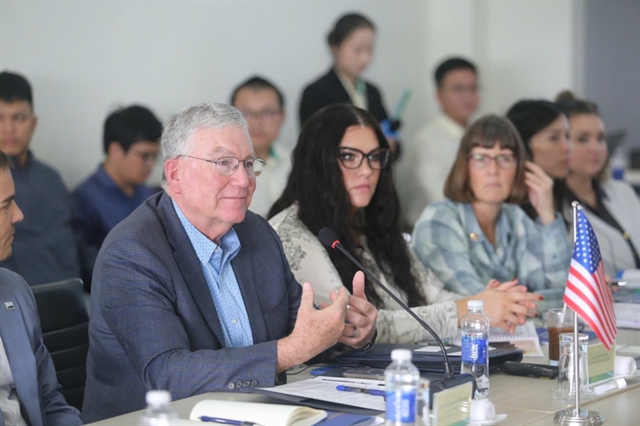 Economy
Economy

Asian Development Bank President Takehiko Nakao has called for more investments in infrastructure to support continued growth in Asia and the Pacific amidst a range of emerging challenges.
 |
| ADB President Nakao delivers an opening speech at the ADB’s Annual Meeting of the Board of Governors in Yokohaman, Japan today. — VNS Photo Ngọc Bích |
YOKOHAMA — Asian Development Bank President Takehiko Nakao has called for more investments in infrastructure to support continued growth in Asia and the Pacific amidst a range of emerging challenges.
Investment infrastructure will remain a priority for ADB as the bank prepares a new long-term strategy to respond to a rapid regional changes, Nakao confirmed while making his opening remark at the 50th Annual Meeting of ADB’s Board of Governors today morning.
“Asia will need US$1.7 trillion per year in investment in power, transport, telecommunications and water through 2030,” the ADB president said, adding that this figure is more than double ADB’s previous estimate, which is an evidence for the region’s huge demands for infrastructure.
Deputy Prime Minister of Japan and the Chairperson of the Board of Governors Taro Aso said that infrastructure needs in Asia are getting larger both in terms of quality and quantity due to economic development.
Thus, private sector funds should also be mobilised, including through Public-Private Partnerships model, Aso said.
Enhancing quality of infrastructure in terms of lifecycle cost and environmental and social considerations is important, he said, emphasising “It is crucial to utilise infrastructure in an open, transparent and non-exclusive manager to enhance its connectivity.”
President Nakao said that ADB will step up efforts to mobilise private sources for development by promoting greater and more effective use of Public-Private Partnerships or PPPs.
He noted that Japan has experiences in this approach, giving an example that in the late 19th century in Japan, many railways and electricity services were started through innovative private companies with the government’s concession loans.
Infrastructure should be incorporated with more advanced technologies, as maintenance costs and the resilience of infrastructure now is also paid much attention, Nakao said.
He added that ADB has initiated reforms to promote greater use of advanced technology during its project preparation and procurement process.
It would establish a trust fund to promote the integration of high-level technology (HLT) and innovative solutions in the design and implementation of its projects in Asia and the Pacific, Nakao said.
Deputy Prime Minister Aso said that Japan would provide $40 million over 2 years to the new trust fund for HLT. With the provision, Japan becomes the first donor of the fund.
Initiatives to improve PPP business environment
Earlier, in an attempt to promote PPPs, ADB announced two new initiatives to improve and monitor the business environment for PPPs in Asia and the Pacific.
The measures aim to strengthen the bankability and implementation of PPPs.
The first initiative is the Infrastructure Referee Program (IRP), which is the first program of its kind in the PPP market.
Under the program, ADB will provide independent third party advice through qualified consultants to help public and private parties resolve disagreements that may arise over the life of a PPP project.
“Disagreements between public and private parties over risk allocation can arise during tendering, negotiation, construction, or operation, potentially triggering protracted delays, increased costs, and failure to deliver critical services,” said Ryuichi Kaga, head of ADB’s Office of Public–Private Partnership (OPPP).
“ADB, through the IRP, will help resolve disagreements between public and private stakeholders and support successful delivery and implementation of PPP projects in Asia and the Pacific.”
The second initiative, the PPP Monitor, is a new ADB publication that tracks the development of the PPP business environment across ADB member countries and provides insight for the public sector on structuring a sound environment for PPPs.
“We know from experience that there is substantial interest from both public and private sectors in PPPs, but they often lack essential information on the PPP environment,” Kaga said.
“The PPP Monitor will provide country-specific information critical not only for sound policy formulation but also for the private sector to make informed business decisions.”
The PPP Monitor tracks each country’s regulatory framework, institutional capacity for project implementation, market maturity, and financial facilities. It also features sector-specific information for each country covered.
The PPP Monitor’s first edition includes information on Bangladesh, the People’s Republic of China, Indonesia, Kazakhstan, Papua New Guinea, the Philippines, Thailand, and Việt Nam. Future editions are expected to cover more countries and include a broader range of factors.
As many as 6,000 government officials, academics, business offices, civil society representatives and members of media gathered at this year’s Annual Meeting themed "Building Together the Prosperity of Asia". The meeting is also a celebration of ADB’s 50 years of development work in Asia and the Pacific.
The opening ceremony was also addressed by Japan’s Crown Prince Naruhito. — VNS




